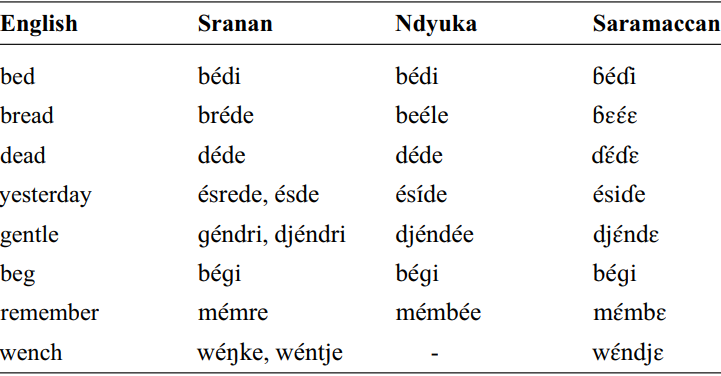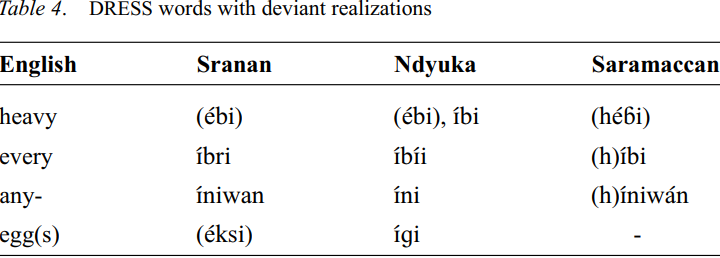


 Grammar
Grammar
 Tenses
Tenses
 Present
Present
 Past
Past
 Future
Future
 Parts Of Speech
Parts Of Speech
 Nouns
Nouns
 Verbs
Verbs
 Adverbs
Adverbs
 Adjectives
Adjectives
 Pronouns
Pronouns
 Pre Position
Pre Position
 Preposition by function
Preposition by function 
 Preposition by construction
Preposition by construction
 Conjunctions
Conjunctions
 Interjections
Interjections
 Grammar Rules
Grammar Rules
 Linguistics
Linguistics
 Semantics
Semantics
 Pragmatics
Pragmatics
 Reading Comprehension
Reading Comprehension
 Teaching Methods
Teaching Methods|
Read More
Date: 2024-03-13
Date: 2024-04-22
Date: 2023-10-18
|
DRESS words with ME /ě/ , and to some extent /ε:/, are represented in Suriname creoles by English words like neck, bed, egg, bread, dead, head, any, bury, ready, etc. The /ε:/ words are generally spelt ea. The normal representation of these differs in the various languages, although the phonemic symbol /e/ is traditionally used in all of them. In Sranan /e/ is usually  for instance. In Ndyuka /e/ is normally [e ~ ε], and in Saramaccan /e,ε/ are usually [e,ε] respectively. /ε/ is employed largely in Saramaccan in these words in combination with an anaptyctic vowel /-ε/.
for instance. In Ndyuka /e/ is normally [e ~ ε], and in Saramaccan /e,ε/ are usually [e,ε] respectively. /ε/ is employed largely in Saramaccan in these words in combination with an anaptyctic vowel /-ε/.

A number of words that belong to this incidence set in RP and AmE have different realizations in the Suriname creoles.

Smith (1987) states: “According to Dobson (1957) raising of /e/ to /i/ is a fairly common process in the fifteenth or sixteenth century in the South-east. In the seventeenth century ships’ logs we find frequent examples of this raising, e.g. chists ‘chests’. Matthews (1938) provides many examples from Cockney including chistes (1553).”
|
|
|
|
دراسة: حفنة من الجوز يوميا تحميك من سرطان القولون
|
|
|
|
|
|
|
تنشيط أول مفاعل ملح منصهر يستعمل الثوريوم في العالم.. سباق "الأرنب والسلحفاة"
|
|
|
|
|
|
|
الطلبة المشاركون: مسابقة فنِّ الخطابة تمثل فرصة للتنافس الإبداعي وتنمية المهارات
|
|
|